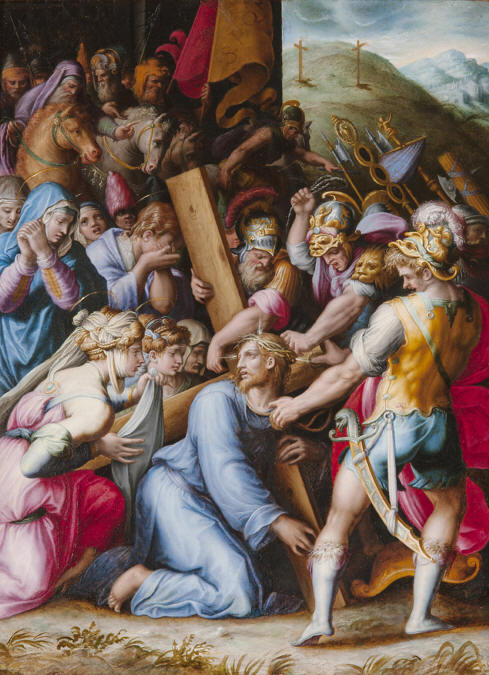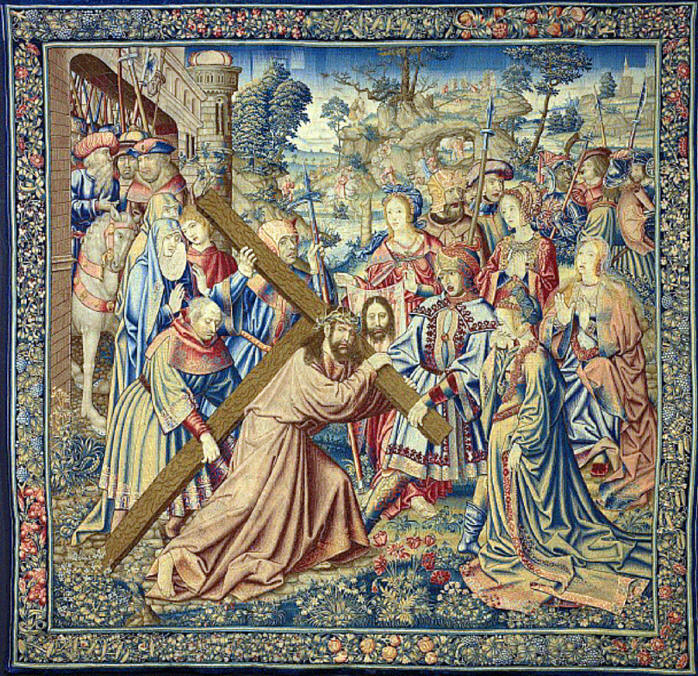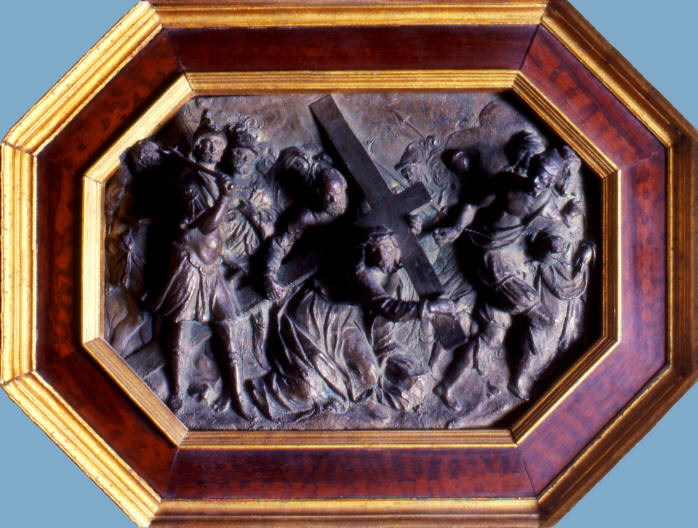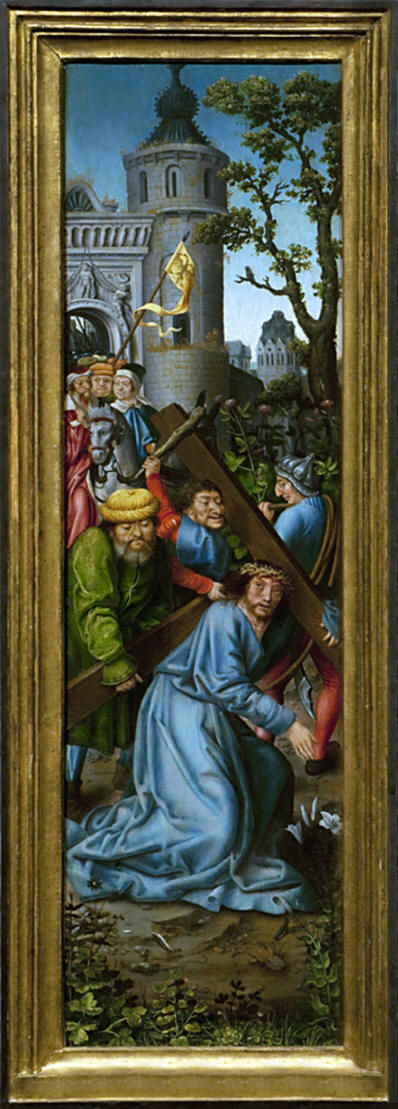

“Portraits of the Passion:
Carrying the Cross to Calvary”
Matthew 27:15-33
Pastor Kevin Vogts
Trinity Lutheran Church
Paola, Kansas
Lent Service III—March 11, 2020
In the Name of the Father and of the Son and of the Holy
Spirit. Amen.
Our Lenten sermon series this year is “Portraits of the Passion,” the
Lenten story illustrated with slides of artworks from the Spencer Museum at the
University of Kansas and the Nelson-Atkins Museum. This evening we
meditate on Christ “Carrying the Cross to Calvary.”
Matthew reports: “Then the governor’s soldiers took Jesus into the
Praetorium and gathered the whole company of soldiers around him. They stripped
him and put a scarlet robe on him, and then twisted together a crown of thorns
and set it on his head. They put a staff in his right hand and knelt in front of
him and mocked him. ‘Hail, king of the Jews!’ they said. They spit on him, and
took the staff and struck him on the head again and again. After they had mocked
him, they took off the robe and put his own clothes on him. Then they led him
away to crucify him.”
The traditional route in Jerusalem on which Christ was forced to carry
his cross, from Pontius Pilate’s palace to Mt. Calvary, is called the “Via
Dolorosa,” Latin for “The Way of Sorrows.” Every Friday, thousands of
Christian pilgrims from all over the world gather in Jerusalem to walk the “Via
Dolorosa.” Especially on Good Friday each year, tens of thousands throng
this street in a very moving remembrance of Christ’s journey on the first Good
Friday. One of the most memorable events in my life was being in Jerusalem
for Holy Week in 1980, and walking the “Via Dolorosa” on Good Friday. In
fact, I bought this purple stole that day in a shop on the “Via Dolorosa.”
Christ’s journey “Carrying the Cross to Calvary” is vividly described
by Paul Maier, a Lutheran pastor and professor of ancient history at Western
Michigan State University. He is also, by the way, the son of the famous
“Lutheran Hour” speaker, Dr. Walter A. Maier.
“[Crucifixion was certainly the most public form of execution.]
From the moment the judgement went against him, the condemned victim was on
display: he had to shoulder his [cross], and carry it in a hideously public
parade out to the place of execution . . . as a public example and warning to
others to avoid his crime, which was plainly stated [on] a placard [which was
carried before him and then] posted above his head [on the cross]. . .
“The route Jesus was forced to take on his final journey to the cross
came to be called, long ago, [the “Via Dolorosa” or “The Way of Sorrows.”]
A centurion, dressed in a Roman uniform, preceded him . . . Four soldiers
formed the execution detail itself, but probably all of the 600 [soldiers] in
Pilate’s Jerusalem [force] were lining the roadsides to control any
demonstrations.
“ . . . Evidently a great crowd of people, including numerous women,
bewailed and lamented his fate. By now news of Jesus’ arrest and
condemnation was spreading through Jerusalem, but too late for his followers to
try to save him . . . people . . . were rushing to the roadside in tears .
. .
“Two other condemned men were also grunting under their [crosses] on
the way out to Golgotha . . . Jesus’ scourging must have been more brutal
. . . than theirs, because he stumbled and collapsed under his [cross], and the
troops had to impress a bystander . . . into carrying the [cross] for him.
“When they reached Golgotha . . . the execution detail stripped
off his clothes . . . divided his garments into four shares . . . [and] cast
lots for his cloak . . .
“Jesus’ hands or wrists were nailed to the [cross] . . . and his feet were spiked onto it.”

“Christ Carrying the Cross”
Circle of Vasari – c. 1571-1574 – Oil on Wood
In this Italian painting from the 1500’s we see many of the elements
Matthew and Professor Maier describe. Christ in a crown of thorns,
stumbling under the weight of the cross. Around him a group of women, including
his mother Mary, pictured as traditional in a blue robe. As Luke reports:
“A large number of people followed him, including women who mourned and wailed
for him.” Mt. Calvary looms ominously in the background, already with two
crosses, awaiting the third, as John says, “Here they crucified him, and with
him two others—one on each side and Jesus in the middle.”

“The Way to Calvary”
Jean de Camp & Pieter van Aelst – Silk & Wool Tapestry – 1510
One of the interesting aspects of the collections of classical
Christian art at the Nelson-Atkins and Spencer Museums is to see how the same
events are portrayed by different artists, using different materials. Like
the previous painting, this silk and wool tapestry at the Nelson-Atkins Museum
is also from the 1500’s. It is the largest artwork we are looking at in
this series, measuring nearly ten feet square.
Luke reports, “[The soldiers] seized Simon from Cyrene, who was on his
way in from the country, and put the cross on him and made him carry it behind
Jesus.” This is portrayed with Simon of Cyrene behind Jesus, helping him
carry the cross.

“Christ Carrying the Cross”
Francesco Fanelli – c. 1630 – Bronze
This Italian bronze plaque from the 1600’s shows the same event in yet
another, different medium. Again, Simon of Cyrene is pictured behind
Jesus, helping him carry the cross. The soldiers carry the clubs that had beaten
Jesus, and the spear that will pierce his side. An unusual aspect of this
sculpture is that Jesus is portrayed being led by a rope. I think the
artist did that because it is poignantly reminiscent of Isaiah’s words, “He was
led like a lamb to the slaughter.”

Detail from “Scenes of the
Passion”
Workshop of the Master of Frankfurt – 1500’s – Oil on Oak Panels
This German painting from the 1500’s is one of five panels from a large
German altarpiece on display at the Spencer Museum of Art. It vividly
portrays Christ’s torturous march out to Mt. Calvary.
Isaiah says, “The Lord has on him the iniquity of us all.” Christ
carrying his cross symbolizes the weight of the sins of the whole world, which
were laid upon him. On account the suffering he endured as your
substitute, your sins are all forgiven. As John says, “He is the atoning
sacrifice for our sins, and not only for ours but also for the sins of the whole
world.”
And there is another comforting message for you in Christ’s agony on
the “Via Dolorosa.” Isaiah says he was “a man of sorrows, and familiar
with suffering.” You know how your LIFE in this world is so often your
own, personal “Via Dolorosa,” a way of sorrows—and God knows it too. Your
God understands your pain, because your God came down to earth and was made man,
and your God himself endured the ultimate way of sorrows. Compressed into
his horrible journey to Mt. Calvary were all the pains, all the sufferings, all
the sorrows of all humanity.
Hebrews says that Jesus is able to “sympathize with us in our
weaknesses” because he himself was “tested in every way, just as we are.”
Politicians often try to connect with people by saying something like, “I feel
your pain.” Your God is not some distant, nebulous Higher Power.
Your God really did “feel your pain” as he carried his cross out to Calvary.
Paul says in Romans, “If God is for us, who can be against us?”
What a comfort to know that in all your struggles, as you face your own personal
“Via Dolorosa,” your own way of sorrows in this life, God is on your side, he
sympathizes, he understands, he truly feels your pain. As Isaiah says, “In
all their distress he too was distressed.”
We continue next week with “The Crucifixion.”
Return to Top | Return to Sermons | Home | Email Church Office